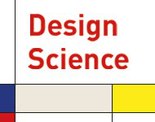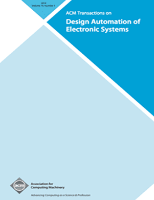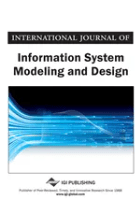
Design Science
Scope & Guideline
Advancing Design Knowledge for a Dynamic World.
Introduction
Aims and Scopes
- Design Methodologies and Processes:
The journal explores different methodologies in design, including systematic approaches, participatory design, and co-design processes. It emphasizes how these methodologies can be applied effectively in various contexts. - Integration of Technology in Design:
Research often focuses on the role of emerging technologies, such as artificial intelligence, machine learning, and generative design, in enhancing design processes and outcomes. - Sustainability and Circular Economy:
A significant focus is placed on sustainable design practices, including assessments related to the circular economy, product lifecycle management, and environmental impact. - Interdisciplinary Approaches to Design:
The journal encourages interdisciplinary research that combines insights from engineering, social sciences, and user experience design to foster innovative solutions. - User-Centric Design and Experience:
Research frequently addresses user experience, stakeholder engagement, and the impact of design decisions on users, highlighting the importance of empathy in the design process. - Educational Innovations in Design:
The journal showcases studies on design education, including methods to improve creativity, learning outcomes, and the integration of technology in educational settings.
Trending and Emerging
- Generative Design and Artificial Intelligence:
Recent publications emphasize the use of generative adversarial networks and AI in design processes, showcasing how these technologies can enhance creativity and efficiency in design. - Health and Well-Being in Design:
There is an increasing focus on the intersection of design, health, and well-being, particularly in relation to tools and environments that support user engagement and learning during and post-pandemic. - Circular Economy and Sustainable Design Practices:
Research is increasingly centered around sustainable design practices, with a strong emphasis on circular economy principles, reflecting a global push towards environmental responsibility. - Co-Design and User Engagement:
The trend towards co-design and user-centric approaches is emerging strongly, with researchers exploring methods to better engage users in the design process and leverage their insights. - Mixed-Methods Approaches in Design Research:
There is a growing trend towards utilizing mixed-methods approaches, combining qualitative and quantitative research to provide more comprehensive insights into the design process. - Impact of Digital Tools on Design Education:
The integration of digital tools and technologies in design education is gaining traction, focusing on how these innovations can enhance learning experiences and outcomes for students.
Declining or Waning
- Traditional Design Methods:
There appears to be a diminishing focus on traditional design methods as the field increasingly embraces innovative and technology-driven approaches. - General Product Development without Sustainability Focus:
Research centered on product development without a sustainability angle is becoming less common, indicating a shift toward more environmentally conscious design practices. - Static Design Frameworks:
The exploration of static frameworks and models for design processes is waning, as there is a growing preference for dynamic and adaptable methodologies that respond to changing conditions. - Exclusively Engineering-Centric Design Studies:
Studies that focus solely on engineering perspectives without considering user experience or interdisciplinary approaches are becoming less frequent, reflecting the journal's broader scope. - Limited User Participation Models:
Research that does not incorporate user participation or co-design principles is being phased out, as the importance of stakeholder engagement in the design process is increasingly recognized.
Similar Journals

Design Studies
Shaping Tomorrow's Design Landscape TodayDesign Studies, published by Elsevier Science Ltd, is an esteemed international journal, recognized for its pivotal contributions to the fields of design, architecture, and engineering. With an impressive history spanning from 1979 to 2024, this journal holds top positions in various categories, including Q1 rankings in Architecture, Arts and Humanities, and Engineering, indicating its high impact and relevance within academic circles. It boasts a notable Scopus ranking of #3 in Engineering & Architecture and #10 in General Social Sciences, demonstrating its multidisciplinary influence and the value it brings to both theoretical and practical aspects of design. Although not an open-access publication, the journal provides comprehensive access options to facilitate the dissemination of groundbreaking research. Catering to researchers, professionals, and students alike, Design Studies aims to foster innovation by publishing high-quality articles that explore contemporary design challenges and solutions, making it an essential resource for those invested in advancing knowledge in this dynamic field.

ACM TRANSACTIONS ON DESIGN AUTOMATION OF ELECTRONIC SYSTEMS
Advancing the Future of Electronic Design AutomationACM Transactions on Design Automation of Electronic Systems is a premier scholarly journal published by the Association for Computing Machinery (ACM), dedicated to advancing the field of electronic system design automation. With an impact factor that reflects its influential contributions, this journal serves as an essential resource for researchers, professionals, and students engaged in computer graphics, computer-aided design, and electrical engineering. Since its inception in 1996, the journal has aimed to foster innovation and collaboration within the engineering community through the dissemination of high-quality research articles, reviews, and tutorials. Positioned in the Q2 quartile across key categories like Computer Graphics and Computer-Aided Design, as well as Electrical and Electronic Engineering, it ranks within the top percentile among its peers—a testament to its scholarly impact. Readers can expect to find cutting-edge research that addresses the challenges and advancements in design automation, fostering a deeper understanding of complex electronic systems. With a commitment to excellence, ACM Transactions on Design Automation of Electronic Systems remains a vital outlet for the latest developments in its field.

International Journal of Information System Modeling and Design
Bridging Theory and Practice in Information System ModelingInternational Journal of Information System Modeling and Design, published by IGI Global, serves as a vital resource for researchers, professionals, and students in the rapidly evolving fields of Information Systems and Management of Technology and Innovation. With an ISSN of 1947-8186 and E-ISSN of 1947-8194, this journal has been a platform for disseminating cutting-edge research and innovative methodologies since its inception in 2010, with converged years extending through 2024. Although it currently holds a Q4 category ranking in both Information Systems and Management of Technology and Innovation, the journal is committed to enhancing its academic influence and aims to provide high-quality content that bridges theoretical frameworks and practical applications. Its Scopus rankings position it among relevant peers, making it an important conduit for advancing knowledge in technology management. Despite not being an open-access publication, the journal's content is backed by rigorous peer review, promising valuable insights for those engaged in the study and application of information systems.

Design Journal
Shaping Tomorrow's Design Practices TodayDesign Journal, published by Routledge Journals, Taylor & Francis Ltd, serves as a pivotal platform for interdisciplinary research within the expansive fields of Arts and Humanities as well as Computer Graphics and Computer-Aided Design. With an ISSN of 1460-6925 and an E-ISSN of 1756-3062, this journal is dedicated to disseminating innovative ideas and methodologies that shape contemporary design practices. Ranked in the Q2 category in Arts and Humanities and Q3 in Computer Graphics per the 2023 category quartiles, it stands as a reference point for scholars and practitioners alike, fostering a vibrant community for sharing knowledge and fostering creativity. Researchers will find the journal's scope particularly valuable as it covers a diverse range of topics, providing insights critical for advancing knowledge and practice. With the journal continuing to evolve—converging research avenues from 2005 to 2024—it thrives as a beacon of scholarly excellence in the United Kingdom and beyond, appealing to professionals, researchers, and students eager to engage with cutting-edge design discourse.

Architectural Engineering and Design Management
Elevating architectural practices through cutting-edge research.Architectural Engineering and Design Management, published by Taylor & Francis Ltd, is a leading journal dedicated to the interdisciplinary fields of architectural engineering and design management. Since its inception in 2005, the journal has established itself as an essential resource for researchers and practitioners, showcasing the latest developments and innovative practices within the architecture and construction industries. With a commendable impact factor reflected in its Q1 ranking in Architecture and high standings across building and construction, it addresses critical themes such as sustainable design, integrated construction processes, and management strategies that drive efficiency and creativity in evolving architectural contexts. Researchers will find the journal's commitment to disseminating high-quality research—evidenced by its impressive Scopus rankings, including a #13 ranking in Architecture—particularly valuable as it fosters a deeper understanding and advancement in the profession. The journal is accessible in print and online, ensuring that academic and professional communities stay at the forefront of architectural engineering innovation.

Journal of Usability Studies
Empowering usability professionals with cutting-edge insights.The Journal of Usability Studies, published by the USERS EXPERIENCE PROFESSIONAL ASSOCIATION, is a pivotal platform for researchers and professionals dedicated to advancing the field of usability and user experience design. With an ISSN of 1931-3357, this journal offers a collection of peer-reviewed articles that explore innovative methodologies, emerging technologies, and applied research in usability studies. Though it operates under a traditional access model, the journal remains dedicated to fostering a detailed understanding of how users interact with systems and products. The Journal of Usability Studies is instrumental for those aiming to enhance user satisfaction through research-backed insights, making it a vital resource for academics, practitioners, and students seeking to contribute to the evolving discourse in human-computer interaction and usability engineering.

JOURNAL OF ENGINEERING DESIGN
Advancing the Future of Engineering DesignJournal of Engineering Design, published by Taylor & Francis Ltd, is a prestigious platform for the dissemination of innovative research and developments in the field of engineering design. With an ISSN of 0954-4828 and an E-ISSN of 1466-1837, this journal has established itself as a vital resource for academics and practitioners alike since its inception in 1984. As a member of the Q2 category in the Engineering (miscellaneous) field for 2023 and ranking 71 out of 307 in general engineering on Scopus, the journal showcases cutting-edge research that pushes the boundaries of design methodology, tools, and applications across various engineering disciplines. Although it is not an open-access publication, its rigorous peer-review process ensures the highest quality of research. The journal's broad scope encompasses topics from product design and materials science to systems engineering and design thinking, making it an essential reading for those keen on the latest trends and advancements in engineering design. Published in the United Kingdom, the journal remains dedicated to nurturing a robust academic community, facilitating scholarly exchange, and providing valuable insights for researchers, professionals, and students engaged in engineering design.

INTERNATIONAL JOURNAL OF HUMAN-COMPUTER STUDIES
Innovating the Interface of Human Experience and TechnologyINTERNATIONAL JOURNAL OF HUMAN-COMPUTER STUDIES, published by Academic Press Ltd - Elsevier Science Ltd, stands at the forefront of research dedicated to the dynamic interplay between humans and technology. With a remarkable impact factor reflective of its rigorous academic standards and its prestigious ranking in the Q1 category across vital disciplines such as Education, Engineering, Human Factors and Ergonomics, and Human-Computer Interaction, this journal serves as an essential resource for researchers, professionals, and students alike. Spanning from 1994 to 2024, it showcases pioneering studies that contribute significantly to the understanding of cognitive processes, usability, and the evolving role of technology in society. Despite the absence of Open Access options, access to this journal is facilitated through institutional subscriptions, ensuring that critical findings and advancements are readily available to a global audience. By continuing to publish high-quality research, the INTERNATIONAL JOURNAL OF HUMAN-COMPUTER STUDIES plays a crucial role in advancing the field, fostering innovation, and guiding future research directions.

Facilities
Fostering scholarly excellence in the dynamics of built environments.Facilities is an esteemed international journal, published by Emerald Group Publishing Ltd, dedicated to advancing the scholarly discourse in the multifaceted areas of architecture, building construction, and human factors and ergonomics. Since its inception in 1983, the journal has celebrated over four decades of research contributions, maintaining a robust E-ISSN of 1758-7131 while its print identifier is ISSN 0263-2772. With its distinguished status, it ranks in the Q1 quartile in Architecture and is positioned in the Q2 quartile for both Building and Construction and Human Factors and Ergonomics in 2023. The journal’s Scopus rankings highlight its relevance, achieving a remarkable 88th percentile in Architecture and 68th percentile in Building and Construction. Although not an Open Access publication, Facilities provides vital insights and research findings that cater to academics, practitioners, and students alike, fostering innovation and informed practices across these dynamic fields. Its commitment to high-quality scholarship makes it an indispensable resource for anyone engaged in improving the interaction between people and the built environment.

Journal of Urban Design
Redefining urban living through critical design perspectives.Journal of Urban Design, published by Routledge Journals, Taylor & Francis Ltd, stands at the forefront of academia, providing a critical forum for discourse on contemporary urban design practices and theories since its inception in 1996. With an impressive impact factor and consistently ranking in the Q1 category across multiple fields—namely Arts and Humanities, Geography, Planning and Development, and Urban Studies—this journal is recognized for its significant contributions to the understanding and shaping of urban environments. Although it does not offer open access, its meticulously curated content remains accessible to those keen on exploring innovative urban design thinking. Researchers, professionals, and students alike will find valuable insights and methodologies aimed at enhancing urban spaces globally, making the journal a vital resource for those committed to the evolution of urban planning and sustainable development strategies.